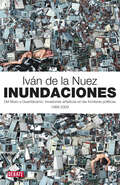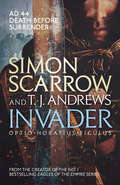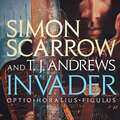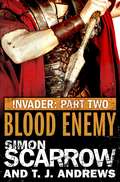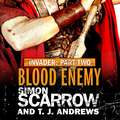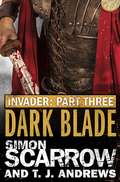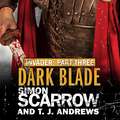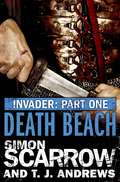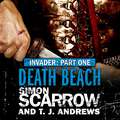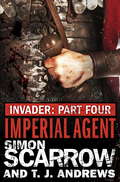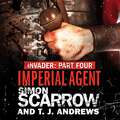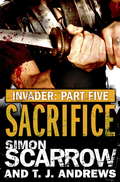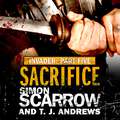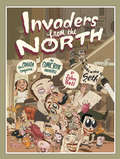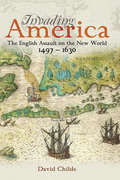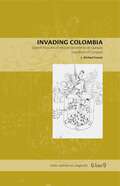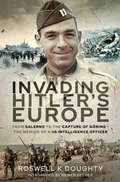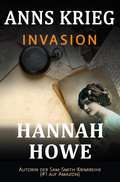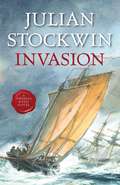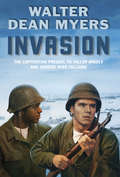- Table View
- List View
Inundaciones: Del Muro a Guantánamo: invasiones artísticas en las fronteras políticas
by Iván de NuezUn repaso a los grandes temas del arte contemporáneo desde 1989. Veinte años de transformaciones políticas. Veinte años de arte contemporáneo. Solo veinte años van de la caída del muro al desmantelamiento de la prisión de Guantánamo. Del fin de la Guerra Fría a la confirmación de la impotencia estadounidense para controlar el mundo que surgió del colapso comunista. A modo de dietario, con un capítulo por cada uno de los 21 años transcurridos, Iván de la Nuez recorre, con su brillantez habitual, todos los recovecos de nuestra experiencia para iluminar el impacto del arte en la historia contemporánea, y de la historia contemporánea en el arte. Un ensayo que demuestra la irremediable unión que existe entre arte, política y sociedad
Invader
by Simon Scarrow T. J. AndrewsINVADER is a Sunday Times bestseller from Simon Scarrow (author of the bestsellers BRITANNIA and CENTURION) and T. J. Andrews, co-author of the bestselling INVADER. Featuring the Roman army officer Figulus in first-century Britannia, INVADER is not to be missed by readers of Conn Iggulden and Bernard Cornwell.Roman Britain, AD 44. The land is far from tamed. A puppet king is doing little to calm the hatred of the native tribes.Fighting is in Optio Horatius Figulus' blood. His Celtic ancestry gives him the toughness essential for survival. That toughness will be tested to the very limit when he is sent on a mission deep in hostile territory. And Figulus knows that, even utterly crushed in battle, their warriors routed and the Druids driven from their hill forts, the tribesmen of Britannia will sooner die than surrender.Figulus fought alongside Macro and Cato in Simon Scarrow's bestselling Eagles of the Empire series. In INVADER, he stands alone.INVADER has previously been published in five separate ebook novellas.
Invader
by Simon Scarrow T. J. AndrewsINVADER is a Sunday Times bestseller from Simon Scarrow (author of the bestsellers BRITANNIA and CENTURION) and T. J. Andrews, co-author of the bestselling INVADER. Featuring the Roman army officer Figulus in first-century Britannia, INVADER is not to be missed by readers of Conn Iggulden and Bernard Cornwell.Roman Britain, AD 44. The land is far from tamed. A puppet king is doing little to calm the hatred of the native tribes.Fighting is in Optio Horatius Figulus' blood. His Celtic ancestry gives him the toughness essential for survival. That toughness will be tested to the very limit when he is sent on a mission deep in hostile territory. And Figulus knows that, even utterly crushed in battle, their warriors routed and the Druids driven from their hill forts, the tribesmen of Britannia will sooner die than surrender.Figulus fought alongside Macro and Cato in Simon Scarrow's bestselling Eagles of the Empire series. In INVADER, he stands alone.INVADER has previously been published in five separate ebook novellas.
Invader
by Simon Scarrow T. J. AndrewsFrom the author of the Sunday Times bestsellers BRITANNIA, CENTURION and THE GLADIATOR, and co-author with T. J. Andrews of the Sunday Times bestseller ARENA, comes a tense, action-packed adventure with the Roman army officer Figulus in the heart of barbaric first-century Britannia. Roman Britain, AD 44. The land is far from tamed. A puppet king is doing little to calm the hatred of the native tribes and bring them under Roman rule.Fighting is in Optio Horatius Figulus' blood. His Celtic ancestry is mocked by his fellow soldiers, but it gives him the toughness essential for survival. That toughness will be tested to the very limit when he is sent on a mission deep in hostile territory.And Figulus understands the Celtic mind. He knows that, even utterly crushed in battle, their warriors routed and the Druids driven from their hill forts, the tribesmen of Britannia will sooner die than surrender.Figulus fought alongside Macro and Cato in Simon Scarrow's bestselling Eagles of the Empire series. In INVADER, he stands alone.INVADER has previously been published in five separate ebook novellas. This print edition brings the complete series together in one volume.
Invader: Blood Enemy (2 in the Invader Novella Series)
by Simon Scarrow T. J. AndrewsThe second novella in the gripping INVADER series, set in Roman Britain, AD 44, from Sunday Times bestselling authors Simon Scarrow and T. J. AndrewsBritannia is a nightmare campaign setting for the brave soldiers of the Second Legion. Horatius Figulus, a junior officer, has been rewarded for bravery and skill against the island's rebel forces with a mission that could bring him prestige and position. He and his most trusted comrades are to help install a new king in a hostile area. Succeed, and they'll establish an imperative Roman stronghold. Fail, and the whole invasion will be jeopardised.Under constant attack from raiders, plagued by ruthless Druids and up against hostile natives, Figulus and his men will need all their courage and ingenuity to succeed.
Invader: Blood Enemy (2 in the Invader Novella Series)
by Simon Scarrow T. J. AndrewsThe second novella in the INVADER series, set in Roman Britain, AD 44, from Sunday Times bestselling authors Simon Scarrow and T. J. AndrewsBritannia is a nightmare campaign setting for the brave soldiers of the Second Legion. Horatius Figulus, a junior officer, has been rewarded for bravery and skill against the island's rebel forces with a mission that could bring him prestige and position. He and his most trusted comrades are to help install a new king in a hostile area. Succeed, and they'll establish an imperative Roman stronghold. Fail, and the whole invasion will be jeopardised.Under constant attack from raiders, plagued by ruthless Druids and up against hostile natives, Figulus and his men will need all their courage and ingenuity to succeed.(P)2018 Headline Publishing Group Ltd
Invader: Dark Blade (3 in the Invader Novella Series)
by Simon Scarrow T. J. AndrewsThe third novella in the gripping INVADER series, set in Roman Britain, AD 44, from Sunday Times bestselling authors Simon Scarrow and T. J. AndrewsDespite defeat in battle, Britannia's natives continue to resist their Roman conquerors. All attempts to impose Roman rule have failed. A new king has been installed among the Durotriges to bring them into line and Optio Horatius Figulus of the Second Legion is charged with protecting him. It's a thankless task and, worse still, the Druids are rumoured to be plotting to assassinate the king. The king begins a devastating campaign of reprisals against his political rivals. Whole families are murdered, weapons are confiscated and the old gods are denounced. As open native rebellion threatens, Figulus finds his unswerving allegiance to Rome faltering. Just as a Druid assassin is poised to strike...
Invader: Dark Blade (3 in the Invader Novella Series)
by Simon Scarrow T. J. AndrewsThe third ebook-exclusive novella in the brand new INVADER series, set in Roman Britain, AD 44, from Sunday Times bestselling authors Simon Scarrow and T. J. Andrews Despite defeat in battle, Britannia's natives continue to resist their Roman conquerors. All attempts to impose Roman rule have failed. A new king has been installed among the Durotriges to bring them into line and Optio Horatius Figulus of the Second Legion is charged with protecting him. It's a thankless task and, worse still, the Druids are rumoured to be plotting to assassinate the king. The king begins a devastating campaign of reprisals against his political rivals. Whole families are murdered, weapons are confiscated and the old gods are denounced. As open native rebellion threatens, Figulus finds his unswerving allegiance to Rome faltering. Just as a Druid assassin is poised to strike...
Invader: Dark Blade (3 in the Invader Novella Series)
by Simon Scarrow T. J. AndrewsThe third novella in the gripping INVADER series, set in Roman Britain, AD 44, from Sunday Times bestselling authors Simon Scarrow and T. J. AndrewsDespite defeat in battle, Britannia's natives continue to resist their Roman conquerors. All attempts to impose Roman rule have failed. A new king has been installed among the Durotriges to bring them into line and Optio Horatius Figulus of the Second Legion is charged with protecting him. It's a thankless task and, worse still, the Druids are rumoured to be plotting to assassinate the king. The king begins a devastating campaign of reprisals against his political rivals. Whole families are murdered, weapons are confiscated and the old gods are denounced. As open native rebellion threatens, Figulus finds his unswerving allegiance to Rome faltering. Just as a Druid assassin is poised to strike...(P)2014 Headline Publishing Group Ltd
Invader: Death Beach (1 in the Invader Novella Series)
by Simon Scarrow T. J. AndrewsThe first novella in the gripping INVADER series, set in Roman Britain, AD 44, from Sunday Times bestselling authors Simon Scarrow and T. J. AndrewsThe invasion of Britannia has been bloody and relentless, and still the barbaric islanders have not been fully conquered. The men of the Second Legion have suffered grievous losses in driving back their bitterest enemy, but worse is yet to come for the beleaguered soldiers. With winter fast approaching, they face a new threat: ferocious native warriors launching coordinated attacks from their secret base on the Isle of Vectis.In response, the new legate announces a plan to invade Vectis and rout the enemy in what he expects to be a speedy and successful mission. But Horatius Figulus, a junior officer with local knowledge of the enemy, doubts the invasion will be so straightforward. And when the Second Legion encounters fierce resistance on the beach, Figulus and his fellow soldiers suddenly find themselves fighting a desperate battle for their lives....
Invader: Death Beach (1 in the Invader Novella Series)
by Simon Scarrow T. J. AndrewsThe first novella in the gripping INVADER series, set in Roman Britain, AD 44, from Sunday Times bestselling authors Simon Scarrow and T. J. AndrewsThe invasion of Britannia has been bloody and relentless, and still the barbaric islanders have not been fully conquered. The men of the Second Legion have suffered grievous losses in driving back their bitterest enemy, but worse is yet to come for the beleaguered soldiers. With winter fast approaching, they face a new threat: ferocious native warriors launching coordinated attacks from their secret base on the Isle of Vectis.In response, the new legate announces a plan to invade Vectis and rout the enemy in what he expects to be a speedy and successful mission. But Horatius Figulus, a junior officer with local knowledge of the enemy, doubts the invasion will be so straightforward. And when the Second Legion encounters fierce resistance on the beach, Figulus and his fellow soldiers suddenly find themselves fighting a desperate battle for their lives....(P)2014 Headline Publishing Group Ltd
Invader: Death Beach (Part One of the Roman Invader Series)
by Simon ScarrowThe first ebook-exclusive novella in the brand new INVADER series, set in Roman Britain, AD 44, from Sunday Times bestselling authors Simon Scarrow and T. J. Andrews The invasion of Britannia has been bloody and relentless, and still the barbaric islanders have not been fully conquered. The men of the Second Legion have suffered grievous losses in driving back their bitterest enemy, but worse is yet to come for the beleaguered soldiers. With winter fast approaching, they face a new threat: ferocious native warriors launching coordinated attacks from their secret base on the Isle of Vectis. In response, the new legate announces a plan to invade Vectis and rout the enemy in what he expects to be a speedy and successful mission. But Horatius Figulus, a junior officer with local knowledge of the enemy, doubts the invasion will be so straightforward. And when the Second Legion encounters fierce resistance on the beach, Figulus and his fellow soldiers suddenly find themselves fighting a desperate battle for their lives....
Invader: Imperial Agent (4 in the Invader Novella Series)
by Simon Scarrow T. J. AndrewsThe fourth novella in the gripping INVADER series, set in Roman Britain, AD 44, from Sunday Times bestselling authors Simon Scarrow and T. J. AndrewsIn the winter of AD 44, Rome's plan to install a friendly king in the most hostile area of Britannia is facing a new threat. There are rumours of a traitor close to the new king, and a new enemy is gathering strength beyond the marshes. As the king continues with his plans to Romanise his subjects, Horatius Figulus, a junior officer in the Second Legion, is charged with training up the new royal bodyguard. But when a trap is sprung on the Roman army, a secretive Druid sect seizes power and takes the king hostage.Now Figulus must infiltrate the enemy ranks, release the king and track down the elusive leader of the Druids - before the whole of Britannia descends into bloody chaos...
Invader: Imperial Agent (4 in the Invader Novella Series)
by Simon Scarrow T. J. AndrewsThe fourth ebook-exclusive novella in the brand new INVADER series, set in Roman Britain, AD 44, from Sunday Times bestselling authors Simon Scarrow and T. J. Andrews In the bitter depths of winter, Rome's plan to install a friendly king in the most hostile area of Britannia is under threat. There are rumours of a conspiracy to unseat the king and Horatius Figulus, the junior officer charged with protecting him, knows the situation is dangerously unstable. But, when the king announces a plan to tax the natives to fund a lavish palace, Figulus is powerless to prevent a violent rebellion. As protests against Roman rule spread, a secretive Druid sect forces out the legion and the king is taken hostage. Now Figulus must infiltrate the enemy ranks, release the king and kill the elusive leader of the Druids before the entire region descends into bloody chaos...
Invader: Imperial Agent (4 in the Invader Novella Series)
by Simon Scarrow T. J. AndrewsThe fourth novella in the gripping INVADER series, set in Roman Britain, AD 44, from Sunday Times bestselling authors Simon Scarrow and T. J. AndrewsIn the winter of AD 44, Rome's plan to install a friendly king in the most hostile area of Britannia is facing a new threat. There are rumours of a traitor close to the new king, and a new enemy is gathering strength beyond the marshes. As the king continues with his plans to Romanise his subjects, Horatius Figulus, a junior officer in the Second Legion, is charged with training up the new royal bodyguard. But when a trap is sprung on the Roman army, a secretive Druid sect seizes power and takes the king hostage.Now Figulus must infiltrate the enemy ranks, release the king and track down the elusive leader of the Druids - before the whole of Britannia descends into bloody chaos...(P)Headline Publishing Group Ltd
Invader: Sacrifice (5 in the Invader Novella Series)
by Simon Scarrow T. J. AndrewsThe gripping final novella in the INVADER series, set in Roman Britain, AD 45, from Sunday Times bestselling authors Simon Scarrow and T. J. Andrews.Britannia, AD 45. Rome's plan to establish a new friendly king over a hostile native tribe is in grave danger. A sinister new Druid sect, led by a charismatic priest, is threatening to destabilise the province and has taken several Roman soldiers prisoner. Now Optio Horatius Figulus faces his most dangerous mission yet. He must venture deep behind enemy lines in search of his captured comrades and the Druids' secret fortress. Can Figulus stop the Dark Moon Druids from inflicting a devastating defeat against the Second Legion? Can he rescue his comrades before they are put to death in a terrifying spectacle?
Invader: Sacrifice (5 in the Invader Novella Series)
by Simon Scarrow T. J. AndrewsThe gripping final novella in the ebook-exclusive INVADER series, set in Roman Britain, AD 45, from Sunday Times bestselling authors Simon Scarrow and T. J. Andrews.Britannia, AD 45. Rome's plan to establish a new friendly king over a hostile native tribe is in grave danger. A sinister new Druid sect, led by a charismatic priest, is threatening to destabilise the province and has taken several Roman soldiers prisoner. Now Optio Horatius Figulus faces his most dangerous mission yet. He must venture deep behind enemy lines in search of his captured comrades and the Druids' secret fortress. Can Figulus stop the Dark Moon Druids from inflicting a devastating defeat against the Second Legion? Can he rescue his comrades before they are put to death in a terrifying spectacle?e to prevail - and save the Second Legion from a devastating defeat.
Invader: Sacrifice (5 in the Invader Novella Series)
by Simon Scarrow T. J. AndrewsThe gripping final novella in the INVADER series, set in Roman Britain, AD 45, from Sunday Times bestselling authors Simon Scarrow and T. J. Andrews.Britannia, AD 45. Rome's plan to establish a new friendly king over a hostile native tribe is in grave danger. A sinister new Druid sect, led by a charismatic priest, is threatening to destabilise the province and has taken several Roman soldiers prisoner. Now Optio Horatius Figulus faces his most dangerous mission yet. He must venture deep behind enemy lines in search of his captured comrades and the Druids' secret fortress. Can Figulus stop the Dark Moon Druids from inflicting a devastating defeat against the Second Legion? Can he rescue his comrades before they are put to death in a terrifying spectacle?(P)2018 Headline Publishing Group Ltd
Invaders from the North: How Canada Conquered the Comic Book Universe
by John BellShort-listed for the 2007 CBA Libris Awards for Book Design of the Year What do Superman, Prince Valiant, Cerebus the Aardvark, and Spawn have in common? Their creators Joe Shuster, Harold Foster, Dave Sim, and Todd McFarlane are Canadians. And while many of the cutting-edge talents of contemporary comix and graphic novels are also from Canada artists such as Chester Brown, Seth, Dave Cooper, and Julie Doucet far too few Canadians realize their country had a remarkable involvement with the "funnies" long before. Invaders from the North profiles past and present comic geniuses, sheds light on unjustly neglected chapters in Canadas pop history, and demonstrates how this nation has vaulted to the forefront of international comic art, successfully challenging the long-established boundaries between high and low culture. Generously illustrated with black-and-white and colour comic covers and panels, Invaders from the North serves up a cheeky, brash cavalcade of flamboyant and outrageous personalities and characters that graphically attest to Canadas verve and invention in the world of visual storytelling.
Invading America: The English Assault on the New World, 1497–1630
by David ChildsA fascinating examination of why England failed for so long to colonize North America, in contrast to Spain’s rapid conquest farther south.Within a generation of Columbus’s first landfall in the Caribbean, Spain ruled an empire in central and south America many times the size of the home country. In stark contrast, after a century of struggle, and numerous disasters, English colonizing efforts farther north had succeeded in settling the banks of one waterway and the littoral of several bays. How and why progress was so slow and laborious is the central theme of this thought-provoking new book. Invading America argues that this is best understood if the development of the English colonies is seen as a protracted amphibious operation, governed by all the factors that traditionally make for success or failure in such endeavors—aspects such as proper reconnaissance, establishing a secure bridgehead, and timely reinforcement. It examines the vessels and the voyages, the unrealistic ambitions of their promoters, the nature of the conflict with the native Indians, and the lack of leadership and cooperation that was so essential for success. Using documentary evidence and vivid firsthand accounts, it describes from a new perspective the often tragic, sometimes heroic, attempts to settle on the American coast and suggests why these so often ended in failure. As this book shows, the emergence of a powerful United States was neither inevitable nor easily achieved.Includes illustrations and a list of historic sites
Invading Colombia: Spanish Accounts of the Gonzalo Jiménez de Quesada Expedition of Conquest (Latin American Originals #1)
by J. Michael FrancisIn early April 1536, Gonzalo Jiménez de Quesada led a military expedition from the coastal city of Santa Marta deep into the interior of what is today modern Colombia. With roughly eight hundred Spaniards and numerous native carriers and black slaves, the Jiménez expedition was larger than the combined forces under Hernando Cortés and Francisco Pizarro. Over the course of the one-year campaign, nearly three-quarters of Jiménez’s men perished, most from illness and hunger. Yet, for the 179 survivors, the expedition proved to be one of the most profitable campaigns of the sixteenth century. Unfortunately, the history of the Spanish conquest of Colombia remains virtually unknown.Through a series of firsthand primary accounts, translated into English for the first time, Invading Colombia reconstructs the compelling tale of the Jiménez expedition, the early stages of the Spanish conquest of Muisca territory, and the foundation of the city of Santa Fé de Bogotá. We follow the expedition from the Canary Islands to Santa Marta, up the Magdalena River, and finally into Colombia’s eastern highlands. These highly engaging accounts not only challenge many current assumptions about the nature of Spanish conquests in the New World, but they also reveal a richly entertaining, yet tragic, tale that rivals the great conquest narratives of Mexico and Peru.
Invading Hitler's Europe: From Salerno to the Capture of Göring—The Memoir of a US Intelligence Officer
by Roswell K. DoughtyA firsthand account of a US Army officer’s part in the liberation of Europe during World War II—from North Africa into the heart of the Third Reich. After graduating from Boston University, Roswell K. Doughty became an Intelligence Officer with the US 36th (Texas) Division. He subsequently saw action in North Africa, then at the disastrous Salerno landings in Italy—where the Allied divisions involved suffered 4,000 casualties—about which the author reveals that suspected intelligence breaches led to the Allies’ plans becoming known to the Germans.Doughty was involved in the grueling battles against the formidable German defenses of the Gustav Line, particularly in the tragic failed attempt to cross the Gari river (Battle of the Rapido River, January 1944) and the struggle to conquer Monte Cassino. After the Anzio landings and the liberation of Rome, Doughty and his infantry regiment, the 141st, took part in the invasion of Southern France in Operation Dragoon, fighting its way up the Rhône River and advancing up to the River Moselle in December 1944. In March 1945, his unit breached the Siegfried Line and crossed into the Germany itself. As an Intelligence Officer, it was also part of Doughty’s duties to interrogate enemy prisoners, which led him to being involved in the capture and detention of Reichsmarschall Go¨ring and in negotiating the surrender of the still-armed and hostile German First Army in May 1945.These are Doughty’s candid recollections from his ground-level point of view. They form a story of survival and a cause for reflection about courage, camaraderie, and the nature of war.
Invasion
by Hannah HoweWährend ihr Ehemann Emrys immer noch vermisst wird, erhält Ann Morgan ein Angebot persönlicher Natur vom charmanten Detective Inspector Max Deveraux. Soll sie dieses Angebot annehmen oder ablehnen? Gleichzeitig steht Ann auch vor einem beruflichen Dilemma. Soll sie nach dem Mord an Trevor Bowman die Zügel seiner Detektivkanzlei in die Hand nehmen? Während Ann über ihr Privat- und Berufsleben grübelt, bittet eine Freundin sie, nach ihrer verschwundenen Tochter zu suchen. Offensichtlich hat diese Tochter, Adeline Hopkins, ein schwieriges Verhältnis zu ihrem Vater. Aber welche Rolle spielen ihr Exfreund und der amerikanische Soldat, mit dem sie kurz ausging? Während sich die GIs darauf vorbereiten, zur zweiten Welle des Vorstoßes gegen die Nazis dazuzustoßen, sucht Ann Antworten, nur um vor ein weiteres Dilemma gestellt zu werden: der Frage, wie der Gerechtigkeit am besten Genüge getan wird.
Invasion
by Julian StockwinIn the 10th volume in the popular high-seas nautical adventure series, rumors fly of Napoleon's planned invasion of England, and British naval commander Thomas Kydd is sent to liaise with American inventor Robert Fulton, who has created "infernal machines" that can wreak mass destruction from a distance. Fulton believes that his inventions, namely the submarine and torpedo, will win the day for the power that possesses them, and Kydd must help him develop the devices. Despite his own belief that standing man-to-man is the only honorable way to fight, Kydd agrees to take part in the crucial testing of these weapons of mass destruction, which just may decide the fate of England.
Invasion
by Walter Dean MyersWalter Dean Myers brilliantly renders the realities of World War II.Josiah Wedgewood and Marcus Perry are on their way to an uncertain future. Their whole lives are ahead of them, yet at the same time, death's whisper is everywhere. One white, one black, these young men have nothing in common and everything in common as they approach an experience that will change them forever. It's May 1944. World War II is ramping up, and so are these young recruits, ready and eager. In small towns and big cities all over the globe, people are filled with fear. When Josiah and Marcus come together in what will be the greatest test of their lives, they learn hard lessons about race, friendship, and what it really means to fight. Set on the front lines of the Normandy invasion, this novel, rendered with heart-in-the-throat precision, is a cinematic masterpiece. Here we see the bold terror of war, and also the nuanced havoc that affects a young person's psyche while living in a barrack, not knowing if today he will end up dead or alive.
